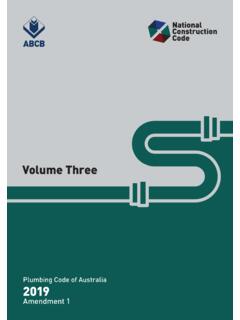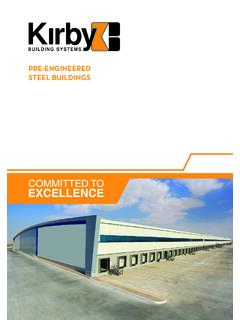Transcription of Building Code of Australia
1 Building Code of Australia Volume Two Class 1 and Class 10 Buildings Housing Provisions SUPERSEDEDSUPERSEDED 1996 Commonwealth and States and Territories of Australia The Building Code of Australia is the copyright of the Commonwealth and the States and Territories of Australia and, apart from any use as permitted under the Copyright Act 1968, no part may be reproduced without prior permission. Requests and enquiries concerning reproduction and rights should be directed in the first instance to the Executive Director, Australian Building Codes Board, GPO Box 9839 Canberra ACT 2601. Australian Building Codes Board GPO Box 9839 Canberra, ACT 2601 Telephone:Canberra (06) 213 7191 Facsimile:(06) 213 7287 The Australian Building Codes Board (ABCB) is established by agreement between the Commonwealth Government and each State and Territory Government. It is a co-operative arrangement between the signatories, Local Government and the Building industry. Standards Australia PO Box 1055 Strathfield NSW 2135 Telephone:(02) 9746 4700 Facsimile:(02) 9746 8450 Standards Australia Important Disclaimer Standards Australia does not accept any responsibility for the content of theBuilding Code of Australia .
2 The Building Code of Australiahas been published as provided by the Australian Building Codes Board. ISBN 1 86264 873 5 (Class 1 and Class 10 Buildings) First published in October 1996 SUPERSEDEDSUPERSEDEDAmdt No. 1 CONTENTS INTRODUCTION 1 Building Code of Australia 1996 Volume Two AND FEATURES [Next page is 11] SUPERSEDEDSUPERSEDEDAmdt No. 1 Page 51 101 1 2 3 4 5 6 7 8 2,015 2,021 Language Continued 11 GENERAL TABLE OF CONTENTS Building Code of Australia 1996 Volume Two CONTENTS AND FEATURES How to Use Introduction The Building Code of Australia The Australian Buildi ng Codes Board The BCA - Content Legislative arrangements Documentation of decisions Structure Further development of the BCA Comments SECTION 1 - GENERAL Application Adoption BCA Volumes BCA Structure Compliance with the BCA Meeting the Performance Requirement Objectives and Functional Statements Deemed-to-Satisfy Provisions Alternative Solutions Assessment Methods Interpretation Definitions Adoption of referenced documents Context of reference Differences between referenced documents and the Housing Provisions Compliance with all Sections of the Housing Provisi ons Application of the Housing Provisi ons to a particular State or Territory Interpretation of diagrams Explanatory information SUPERSEDEDSUPERSEDED12 Continued Page 2.
3 601 Dampness Continued GENERAL TABLE OF CONTENTS Building Code of Australia 1996 Volume Two Acceptance of design and construction 2,201 Suitability of materials Evidence of suitability Fire resistance of Building elements Early fire hazard indices Classification 2,401 Principles of classificat ion Classifica tion Multiple classific ations Standards adopted by reference Schedule of referenced documents SECTION 2 - PERFORMANCE PROVISIONS Application 3,021 Structure 3,031 Damp and weatherproofing 3,201 Surface water Weatherproofing Drainage from swimming pools Fire safety 3,401 Protection from the spread of fire Fire detection and early warning Heating appliances Bushfire areas Alpine areas Health and amenity 3,601 Wet areas Room heights Facilities Light Ventilation Sound insulation SUPERSEDEDSUPERSEDEDAmdt No. 1 GENERAL TABLE OF CONTENTS Continued Page 3,801 i4,031 5,021 5,201 5,801 Continued 13 Building Code of Australia 1996 Volume Two Safe movement and access Stairways and ramps Barriers Swimm ng pools access SECTION 3 - ACCEPTABLE CONSTRUCTION How to Use Introduction The scope of these provisions Suitability of Alternative Solutions The use of maps Consultation with appropriate authorities Layout of Parts - How to use the requirements of each Part Site preparation Earthworks Application Earthworks Excavation adjacent to vacant adjoining property Excavation adjacent to existing buildings Fill Drainage Acceptable construction manual Application Drainage requirements Surface water drainage Subsoil drainage Stormwater drainage Termite risk management Definitions Application of this Part Acceptable construction manual Application installation of termite barriers Barriers for concrete slab-on-ground Protection of suspended floors SUPERSEDEDSUPERSEDED14 [Next page is 21]
4 Continued Page Preparation 7,201 7,401 Concrete 7,601 7,801 9,012 9,021 Continued GENERAL TABLE OF CONTENTS Building Code of Australia 1996 Volume Two Footings and slabs 7,021 Definitions Acceptable construction manuals Application Excavation for footings Filling under concrete slabs Foundations for footings and slabs Slab edge support on sloping sites Stepped footings Vapour barriers Edge rebates Concrete and reinforcing Steel reinforcement Site classification Site classificat ion Footing and slab construction Footing and slab construction Footings and slabs to extensions to existing buildings Shrinkage control Minimum edge beam dimensions Footings for fireplaces on Class A and S sites Stump footing details Masonry Definitions Unreinforced masonry Acceptable construction manual Application External walls Internal walls Isolated piers Masonry units Mortar mixes SUPERSEDEDSUPERSEDEDAmdt No. 1 GENERAL TABLE OF CONTENTS Continued Page joints 9,301 9,601 Weatherproofing 9,801 10,101 Framing 11,051 11.
5 101 21 Building Code of Australia 1996 Volume Two Mortar Vertical articulation joints Sub-floor ventilation Shrinkage allowance for timber framing Reinforced masonry Acceptable construction manual Application External wall construction Masonry accessories Acceptable construction manual Application Wall ties Fixing straps and tie down systems Lintels Definitions Acceptable construction manual Application W idth of cavity Cavity ventilation and drainage Damp proof courses - materials Damp proof courses - nstallation Flashings Weatherproofing for s ngle skin masonry walls Earthwall construction Definitions Acceptable construction manual Application General construction Minimum thickness of walls Weatherproofing Explanation of terms Sub-floor ventilation Application Sub-floor ventilation Continued SUPERSEDEDSUPERSEDED22 Continued Page General Materials 12,201 13,021 13,301 Materials GENERAL TABLE OF CONTENTS Building Code of Australia 1996 Volume Two Steel framing 11,301 Acceptable construction manuals Application Steel floor framing Steel wall fram ng Steel roof fram ng installation of services Timber framing 11,601 Acceptable construction manuals Application Floor framing Flooring Wall framing Conventional roofs Acceptable timber frame s zes and fixing Bracing of t mber frames Structural steel members Explanation of terms Acceptable construction manuals Application Structural steel members Columns Corrosion protection Roof and wall cladding Roof cladding Acceptable construction manuals Applicati on Roof tiling Metal sheet roofing Gutters and downpipes Acceptable construction manuals Application Continued SUPERSEDEDSUPERSEDEDAmdt No.
6 1 GENERAL TABLE OF CONTENTS Continued Page i15,021 lining 15,021 Definitions Human iDoors Full 17,021 Roof lights 23 Building Code of Australia 1996 Volume Two Selection of guttering installation of gutters Downpipes - s ze and installation Wall cladding Applicati on Timber weatherboard cladding Fibre cement planks and weatherboard cladding Sheet wall cladding eaves and soffit Flashings to wall openings Glazing Acceptable construction manual Applicati on Glazing sizes and install ation Perimeter framed glazing mpact safety requirements Side panels height framed glazed panels Glazed panels, other than doors or side panels, on the perimeter of rooms Shower doors, shower screens and bath enclosures Fire safety Fire separation Application General concession - non combustible materials External walls of Class 1 buildings Measurement of distances Construction of external walls Class 10a buildings Allowable encroachments Separating walls Sarking type materials Continued SUPERSEDEDSUPERSEDED24 Continued Page 17,301 17,501 17,701 17,901 19.
7 021 Definitions GENERAL TABLE OF CONTENTS Building Code of Australia 1996 Volume Two Smoke alarms Application Requirements for smoke alarms Location - Class 1a buildings Location - Class 1b buildings Explanatory information - Smoke alarms Heating appliances Acceptable construction manuals Application Open fireplace construction Chimney construction installation of insert fireplaces and flues installation of free standing heating appliances Bushfire areas Acceptable construction manuals Application Bushfire protection Alpine areas Applicati on External doorways External ramps Discharge of external doorways providing means of egress External trafficable structures Health and amenity Wet areas Acceptable construction manual Applicati on Wet areas Materials - general Protection of shower floors in wet areas Protection of walls n wet areas Sealing of wall and floor junctions and joints Continued SUPERSEDEDSUPERSEDEDAmdt No. 1 GENERAL TABLE OF CONTENTS Continued Page Facilities Light Natural l21,021 Thresholds Balustrades Continued 25 Building Code of Australia 1996 Volume Two Room heights 19,301 Application Ceiling heights 19,501 Applicati on Required facilities 19,701 Applicati on ighting Artificial lighting Ventilation 19,901 Acceptable construction manual Applicati on Ventilation requirements Location of sanitary compartments Sound insulation 20,101 Applicati on Sound insulation requirements General install ation requirements for walls Soil and waste pipes Safe movement and access Stair construction Definitions Application General requirements Stair construction Riser and going dimensions 21,201 Application W hen balustrades are required Balustrade construction SUPERSEDEDSUPERSEDED26 GENERAL TABLE OF CONTENTS [Next page is 51]
8 Continued Page Swimming pool access 21,401 Acceptable construction manual Application Safety fencing location and construction Additional construction requirements High wind areas 23,021 Acceptable construction manuals Earthquake areas 23,201 Definitions Acceptable construction manuals Applicati on Construction requirements Construction for areas with an acceleration coefficient of to Construction for areas with an acceleration coefficient of or greater Structural design manuals Acceptable construction manuals 25,021 Applicati on Acceptable structural design manuals Loading requirements Structural design manuals APPENDIX A - State and Territory Additions 50,001 INDEX ABBREVIATIONS AND SYMBOLS 55,001 HISTORY OF AMENDMENTS 57,001 Building Code of Australia 1996 Volume Two SUPERSEDEDSUPERSEDED51 Amdt No. 1 HOW TO USE GENERAL INFORMATION The Building Code of Australia (BCA) is in two loose-leaf volumes. It is written and maintained by the Australian Building Codes Board (see Introduction ).
9 PAGE NUMBERS You may notice gaps in the page numbering sequence. These are necessary in a loose-leaf publication so that new material can be easily inserted. Where such a gap occurs, there is a reference to what the next page number will be, for example: [Next page is 3,601] CLAUSE NUMBERS Within each Section, there are a number of Parts and clauses. The number of the relevant clause (or specification) appears at the bottom of each page. INDEX There is a separate Index marked Index Abbreviations and Symbols . It covers the deemed-to-satisfy provisions in the Code. References in the Index are to clauses or specifications. ABBREVIATIONS AND SYMBOLS Abbreviations and symbols used in the BCA are conveniently located in the Index Abbreviations and Symbols . HISTORY OF AMENDMENTS See under the History of Amendments for an ongoing record of all amendments to the BCA. This section sets out when the BCA and the amendments are adopted by the Commonwealth and each of the States and Territories.
10 It also sets out a brief summary of the purpose of each amendment to the BCA. Building Code of Australia 1996 Volume Two SUPERSEDEDSUPERSEDED52 HOW TO USE [Next page is 101] LOOSE-LEAF AMENDMENTS A loose-leaf amendment contains pages that need to be filed (as a result of amendments to the BCA) into the volume. Each loose-leaf amendment is accompanied by a Filing Record sheet which tells you which pages to remove from the volume and which new ones to insert. AMENDMENT NUMBER AND DATE OF ADOPTION Each odd-numbered page of a loose-leaf amendment includes an amendment number located at the top left corner. For example: Amdt No. 1 This amendment number indicates that the page was inserted by Amendment No 1. The amendment number, its date of adoption and a summary of changes are provided with each loose-leaf amendment. It is important to check the date of adoption as it may not be the same for all States and Territories (see History of Amendments ). Amendments to clauses of the BCA are indicated on the relevant pages.






